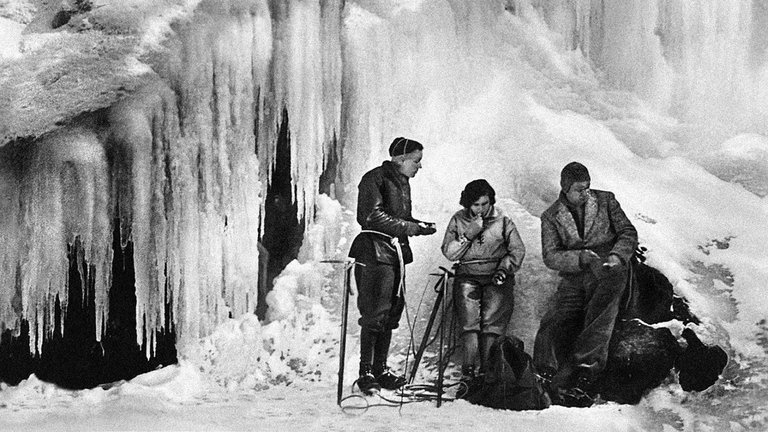Film Review: The White Hell of Pitz Palu (Die weiße Hölle vom Piz Palü, 1929)

Many genres are or were specific to particular national cinema. Americans have westerns, Chinese have wuxia films, Japanese have jidai geki and Yugoslavia had Partisan films. One of peculiarities of German cinema in interwar period was popularity of so-called “mountains films” (“Bergfilme”), genre that combined adventure, melodrama, action and some breathtaking locations. The genre are almost single-handedly created by Dr. Arnold Fanck, geologist with passion for mountain climbing and cinema. Among his films the most successful was The White Hell of Pitz Palu, 1929 silent film co-directed with Georg W. Pabst.
The plot is set in Bernina Alps in southeast Switzerland, and starts in October 1925 when Dr. Johannes Krafft (played by Gustav Diessl) loses his wife Maria (played by Mizzi Götzel) during the attempt to climb 3900 m high Pitz Palü mountain. Krafft never recovered wife’s body, trapped in glacier ice, and spent next four years trying to find it, becoming obsessed recluse, nicknamed “Ghost of Mountain” by the locals. In 1929 Maria Maioni (played by Leni Rifenstahl) and her fiancé Hans Brandt (played by Ernst Petersen) at Diavolezza Hut, at the height of 2990 m, where they meet Krafft. Trio decides to try climbing the summit, but an avalanche injures both men who are, together with Maria, stranded near the top and at the mercy of the elements. Experienced mountain guide Christian (played by Otto Spring) organises rescue mission which will be joined by couple’s friend, famous aviator Ernst Udet (playing himself).
The White Hell of Pitz Palu represented technical marvel for the standards of its age. The film's cinematography, by Fanck's long-time collaborators Sepp Allgeier, Richard Angst, and Hans Schneeberger, is breathtaking. The camera work captures the majesty and grandeur of the mountains, as well as the precariousness and danger of climbing them. The film's use of natural light, and its ability to capture the changing weather conditions, from bright sunshine to blinding snowstorms, is truly impressive.
Film was further enhanced by sensible division of task between two directors – with Fanck taking care of outdoor shots, made on authentic locations of Bernine Alps, while Pabst took care of interiors and worked on the actual drama. The film's pacing is deliberate, and it takes its time to establish the characters and the setting. The film's use of montage, particularly in the climbing sequences, is effective in building tension and creating a sense of danger and urgency. The film's sets, costumes, and props are all meticulously designed and executed, adding to the film's overall aesthetic. The film's use of music, by Willy Schmidt-Gentner, is also effective in creating a sense of atmosphere and mood.
The acting is also commendable. Gustav Diessl delivers a convincing performance as Krafft, a man consumed by grief and haunted by the memory of his lost wife. Leni Riefenstahl, who would later become infamous for her role in promoting Nazi ideology, is at her best as an actress. Her portrayal of Maria Maioni is nuanced and compelling, and she has a natural charisma that shines through on screen. Rifenstahl, who had worked with Fanck on his previous film Holy Mountain, suffered during production, being frostbitten and developing health problems that would plague her to the rest of her life. But she also gained valuable experience in front of cameras that would use in her own directorial debut The Blue Light, another mountain film, made with sound three years later.
However, The White Hell of Pitz Palu has flaws that can’t be ignored, even with technical limitations of late 1920s cinema taken into account. The film's pacing is at times slow, and especially during the ending which is very confusing. Probably due to Fanck being too much in love with his footage, the film is over two hours long, while the story is much simpler and it could have been told much better in hour and half. Some of the dialogue is stilted and unnatural.
The White Hell of Pitz Palu nevertheless became big hit in Germany, even with audience being increasingly demanding sound in cinema. Somewhat ironically, the film that helped pave Leni Rifenestahl stardom and her career in Third Reich, later became suppressed by Nazi regime over some of the people behind and in front of camera being Jews, like the unfortunate actor Kurt Gerron, who would perish in Auschwitz. Many decades later, The White Hell of Pitz Palu became object of numerous references in Tarantino’s Inglorious Basterds. In 1950 a sound remake, starring Hans Albers and Liselotte Pulver, was made in West Germany.
RATING: 7/10 (+++)
Blog in Croatian https://draxblog.com
Blog in English https://draxreview.wordpress.com/
InLeo blog https://inleo.io/@drax.leo
Hiveonboard: https://hiveonboard.com?ref=drax
Rising Star game: https://www.risingstargame.com?referrer=drax
1Inch: https://1inch.exchange/#/r/0x83823d8CCB74F828148258BB4457642124b1328e
BTC donations: 1EWxiMiP6iiG9rger3NuUSd6HByaxQWafG
ETH donations: 0xB305F144323b99e6f8b1d66f5D7DE78B498C32A7
Posted using CineTV